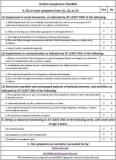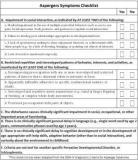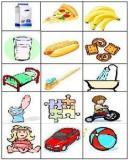Autism Symptoms and Treatments
Learn how to identify the most common autism symptoms, such as hand flapping and repetitive behavior. Early signs may include delayed toddler speech development and/or limited eye contact. So, if you are noticing any of these you should be sure to review the free printable checklist. You may also want to consider reviewing the pages about sensory processing disorder. This disorder can be very similar to symptoms of mild autism, and often coexists with the disorder. As a parent, it can sometimes be difficult to determine whether there is an actual speech delay or whether the child is just progressing at his/her own pace.
Most school systems will evaluate your child for free and it’s better to be told that your child is progressing normally than to wait and realize you could have gotten help sooner. Although our son does not have autistic disorder, but a sensory disorder instead, we had thought something wasn’t quite right all throughout his second and third years afraid it may be autism symptoms. We finally decided to have him evaluated at 2 ½ years old. He qualified for essentially free services from a speech therapist and developmental therapist until his third birthday.
Now that he is older, his speech has gotten to be tremendous and the only thing we still notice is his constant sensory seeking. He doesn't qualify for any services anymore, but I am so glad for the ones we did get. Our developmental therapist was awesome and taught even me so much!
General Characteristics for Autism
Every child with autistic disorder is unique. There is a general list of autism symptoms, but each individual will have a different combination of those. They may or may not have all of them and the severity of each will differ as well.
Some of these include resistance to changes in routine, preferring to be or play alone, and social impairments. You may also notice excessive temper tantrums and/or odd types of play. For more general characteristics check out the page link above or download the free printable checklist.
Autism Symptoms Checklist
I realize for some parents it can be difficult when your child may have early symptoms. It does not necessarily mean your child has autistic disorder, but if you are really concerned you should strongly consider downloading the checklist and consulting with your pediatrician about it.
Signs in Infants
Early Autism Symptoms for Toddlers
Identifying any possible symptoms in extremely young children can make a huge difference in the success of therapy. If you have been wondering whether your infant or toddler has been showing signs, I urge you to check out this page. This will help you to identify early signs, so that treatment can be implemented as soon as symptoms are detected. Having one or two of these is not necessarily a cause for concern, but 6 or more should definitely be discussed with your child's doctor. You may also have a free service in your state that's only available until the child is 3 years old, so the sooner you know there is an issue the sooner you will be able to access these free services.
Autism Signs as defined by the DSM-IV
This checklist is based on the Diagnostic and Statistical Manual of Mental Disorders - Fourth Edition (DSM-IV) behavior characteristics of autism. This is what would be used when officially making any type of diagnosis.
Symptoms of Mild Autism
Based on the results of the checklist you may find that your child has some of the symptoms, but to a lesser degree. Your child may have perfectly normal developing speech, but limited eye contact, repetitive behaviors, and social skills deficits. Because the disorder is considered to be "on a spectrum" there are many different levels of autism, including a mild form.
Asperger Syndrome Behavior
High functioning autism symptoms used to be more commonly diagnosed as asperger disorder. However, with the release of the DSM-V, this is no longer being classified as Asperger Syndrome. Despite this, I think it's still important to identify whether your child may be on this end of the the Autism Spectrum, so I am leaving this information available for families to view. If your child has great speech, but you still feel like something is just not right, you may want to download the free checklist as well as read the page with what used to be classified as typical Aspergers symptoms.
Pervasive Developmental Disorders
Autistic Disorder is a neurodevelopmental disorder classified in the Diagnostic and statistical manual of mental disorders (Fourth edition---text revision)-DSM-IV as a Pervasive Developmental Disorder (PDD). It may also be referred as early infantile autism, childhood autism, or Kanner’s autism<span style='font-size: 50%'>(1). Other developmental disorders that appear similar in nature, include:
Rett’s Syndrome
Rett’s Syndrome involves severe speech delays and loss of social interactions. Onset is as early as 5 months of age, but prior to 4 years of age. It has four stages of development with the final stage lasting for years and resulting in prominently reduced mobility. This generally occurs in girls with the notable symptom of hand wringing.
Childhood Disintegrative Disorder
Childhood disintegrative disorder is a condition that is often misdiagnosed as autistic disorder. The child will appear to be developing normally and then have a sudden regression in acquired skills. The symptoms of this disorder also include impaired social skills, verbal and nonverbal language, adaptive behavior, and repetitive stereotypical behavior.
Causes
Research is currently suggesting multiple causes due to so many different autism symptoms. Currently, the only known cause is Fragile X Syndrome, which is a genetic condition. However, there are multiple theories including a correlation between autism and vaccinations.
Statistics
Statistics show an increasing trend over the past few decades. Many believe this is simply because we are better at identifying the disorder, but if this were true then where are all of the 40 or 50-year-olds that have it? In 2009 the US Centers for Disease Control revised the autism prevalence rate to one in 110 children, making the disorder almost 8 times more likely to occur than Down Syndrome. For more statistics, click on the link above.
Treatments
There are a variety of options available to treat autism symptoms. Some of these include applied behavior analysis, utilizing a special autism diet, speech therapy for children, occupational therapy, DIR Floortime, and Relationship Development Intervention. Information about these can be found by clicking the link above.
Parents may also consider getting help from a behaviorist to develop a behavior intervention plan that provides proactive and reactive strategies for behaviors, such as transition strategies and/or how to deal with self injury. The behaviorist would then continue to come into the home to train the family and caregivers working with the child, help with arising challenges, and possibly even provide crisis support.
Many states have free programs for early intervention. One available in North Dakota, The K.I.D.S. Infant Development Program, is a state-wide early intervention program that provides free comprehensive developmental assessments for all children in the state. If the child does have autism symptoms or some type of delay, the parents can get recommendations for what to work on with their child and if a child has a significant delay he or she is eligible for the program if the parents choose.
Indiana also has a free program, First Steps, that is a family-centered, locally-based, coordinated system providing early intervention services to infants and young children with disabilities or who are developmentally vulnerable.
Additional recommended pages:
Sensory Disorder Symptoms
Sensory Modulation Disorder
Wilbarger Brushing Protocol
ABA Schools
ABA Therapists
Free Child Behavior Help Book
Compliance Strategies for Defiant Children
Dealing with picky eaters
Sleep problems
Skin Picking
Aggressive Behavior
Potty Training Guide
Child Behavior Help Resources
Effects of Red Dye 40 on Behavior
References
1. American Psychiatric Association. (2000). Pervasive developmental disorders. In Diagnostic and statistical manual of mental disorders (Fourth edition---text revision (DSM-IV-TR). Washington, DC: American Psychiatric Association,70-75.


